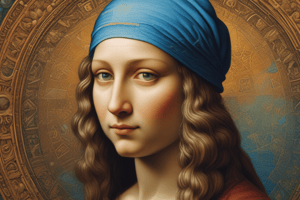Podcast
Questions and Answers
What is the period of time referred to as the Renaissance?
What is the period of time referred to as the Renaissance?
- From the late 17th century until the early 19th century
- From the mid-18th century until the late 19th century
- From the early 10th century until the late 13th century
- From the early 15th century until the mid-17th century (correct)
What is the meaning of the term 'Renaissance'?
What is the meaning of the term 'Renaissance'?
- Rebirth (correct)
- Reform
- Revolution
- Transformation
Which cities were mentioned as centers of cultural transformation during the Renaissance?
Which cities were mentioned as centers of cultural transformation during the Renaissance?
- Florence, Venice, Rome (correct)
- Moscow, Istanbul, Athens
- Paris, Madrid, Berlin
- London, Amsterdam, Vienna
What was at the heart of the Renaissance in terms of intellectual revival?
What was at the heart of the Renaissance in terms of intellectual revival?
What did humanist schools promote during the Renaissance?
What did humanist schools promote during the Renaissance?
Who played a significant role in the rediscovery of ancient texts during the Renaissance?
Who played a significant role in the rediscovery of ancient texts during the Renaissance?
Who among the following Renaissance masters revolutionized sculpture by infusing lifelike qualities into artworks?
Who among the following Renaissance masters revolutionized sculpture by infusing lifelike qualities into artworks?
Which innovative technique, utilizing light and dark contrasts to create depth in art, emerged during the Renaissance?
Which innovative technique, utilizing light and dark contrasts to create depth in art, emerged during the Renaissance?
Who proposed the groundbreaking heliocentric theory during the Renaissance, challenging conventional wisdom?
Who proposed the groundbreaking heliocentric theory during the Renaissance, challenging conventional wisdom?
Which architectural innovator contributed to expanding the understanding of space, volume, and proportion during the Renaissance?
Which architectural innovator contributed to expanding the understanding of space, volume, and proportion during the Renaissance?
What concept in painting, developed during the Renaissance, allowed viewers to perceive three dimensions on a two-dimensional surface?
What concept in painting, developed during the Renaissance, allowed viewers to perceive three dimensions on a two-dimensional surface?
Which Renaissance artist observed celestial bodies through telescopic lenses and made significant astronomical discoveries?
Which Renaissance artist observed celestial bodies through telescopic lenses and made significant astronomical discoveries?
Flashcards are hidden until you start studying
Study Notes
A Glance into the Flourishing Era of the Renaissance
In the heart of Europe during the late Middle Ages, a wave of cultural transformation swept across cities like Florence, Venice, and Rome, ushering in what we now know as the Renaissance — a period enriched with intellectual curiosity and artistic innovation. Spanning roughly from the early 15th century until the mid-17th century, this epoch left indelible marks of progress on society's collective conscience.
The term "Renaissance," which translates to "rebirth" in French, speaks volumes about the ideological foundations upon which this era thrived. Building upon medieval traditions while also yearning for new discoveries, thinkers, artists, and scholars transcended boundaries to explore the realms of humanism, science, philosophy, and art.
Humanistic Pursuits & Education
At the heart of the Renaissance lay a revival of classical learning known as Humanism. With the rediscovery of ancient texts by scholars such as Lorenzo Valla, Cristoforo Landino, and others, humanity began to refocus its attention towards Greek and Roman authors, culture, and ideals. Through education, individuals were encouraged to cultivate their minds, break free from religious dogma, embrace critical thinking, and apply their knowledge to improve society. As humanist schools gained prominence throughout Italy, they became hotbeds of knowledge, promoting idealized versions of virtue and citizenship.
Artistic Endeavors
As the pursuit of higher thought and learning flourished, so too did the arts. Renaissance masters such as Leonardo da Vinci, Raphael, Michelangelo, and Titian pushed the limits of traditional mediums, making strides in painting, sculpture, and architecture that would change the course of Western civilization forever. Fostering an environment conducive to creativity and experimentation, patrons like Medici family members supported these visionaries, employing them to decorate churches, palaces, and villas with masterful works of art.
One of the most significant developments during the Renaissance was the concept of perspective in painting, allowing viewers to perceive three dimensions on a two-dimensional surface. Additionally, the shift away from flat surfaces gave birth to chiaroscuro — a technique utilizing light and dark contrasts to create depth within a portrait or scene. In sculpture, artists like Donatello revolutionized the field by infusing life-like qualities into works previously devoid of emotion and expression. Thanks to architectural innovators such as Filippo Brunelleschi, Lorenzo de' Medici, and Andrea Palladio, grandiose structures like St. Peter's Basilica expanded our understanding of space, volume, and proportion.
Scientific Advances
Whilst the world marveled at the beauty of art and intellectually stimulating discussions, it was also a time when scientific discovery took flight. Nicolaus Copernicus challenged conventional wisdom by proposing his groundbreaking heliocentric theory; Johannes Kepler introduced the laws of planetary motion; Galileo Galilei observed celestial bodies through telescopic lenses and published landmark findings regarding the solar system and astronomical phenomena. Advances in medicine and anatomy led to the writings of Andreas Vesalius’ "De Humani Corporis Fabrica Libri Septem," which overturned prevailing beliefs about the structure of the human body, paving the way for modern medical practice.
In summary, the Renaissance represented a transformational chapter in history, characterized by the rebirth of classical values and the emergence of revolutionary concepts in art, literature, philosophy, and science. This profoundly influential era laid the foundation for many of the advancements seen today, providing a firm basis for continued exploration and fascination.
Studying That Suits You
Use AI to generate personalized quizzes and flashcards to suit your learning preferences.




